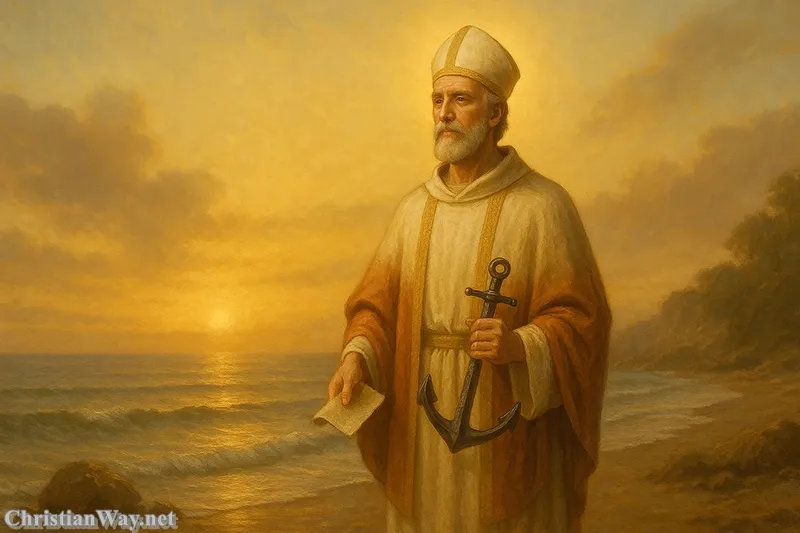Dear friends in Christ,
In every age, the Holy Spirit raises up shepherds who, by their words and example, hold the Church together in charity and truth. Among the first successors of Saint Peter, one man stands out for his steadfast wisdom and apostolic heart: Saint Clement I, also known as Pope Clement of Rome.
As the fourth pope of the Catholic Church, following Peter, Linus, and Cletus, Clement led the Church during one of its most formative and turbulent times. He lived at the close of the first century — an era still echoing with the voices of the Apostles, yet already marked by division, persecution, and the challenge of preserving unity in the Body of Christ.
Through his teaching, his famous Letter to the Corinthians, and his final witness in martyrdom, Saint Clement I became a pillar of the early Church — remembered not only as pope and martyr but as one of the great Apostolic Fathers whose faith still shapes Christian life today.

Let us journey back to that sacred century, when the blood of the martyrs was still fresh on Roman soil, and faith in Christ demanded courage, fidelity, and love.
The Early Life of Saint Clement I — From Rome to the Faith of the Apostles
A disciple of Peter and Paul
Tradition holds that Saint Clement was born into a noble Roman family, possibly of Greek origin. Ancient writers like Tertullian, Irenaeus, and Origen record that he was personally taught and baptized by the Apostles — some say by Saint Peter, others by Saint Paul.
He lived in a world where the Christian faith was young and fragile. The Church in Rome was still a small community meeting in homes, hidden from the suspicion of the imperial authorities. Yet Clement’s heart was captivated by the Gospel and by the holiness of those first witnesses of Christ’s resurrection.
Through prayer, service, and perseverance, Clement became one of Peter’s close collaborators — learning not only the truth of Christ’s words but the art of humble leadership. When his time came, he would carry that same apostolic spirit into his own papacy.
The Fourth Pope of the Catholic Church — A Shepherd After Peter’s Heart
After the martyrdoms of Saint Peter and Saint Paul, and the brief pontificates of Saint Linus and Saint Cletus, Clement was chosen as the fourth pope — the bishop of Rome around the year 88 A.D.
The Church was still recovering from waves of persecution under Emperor Domitian. Many believers had been executed; others were in hiding. To serve as pope at that time was not a privilege but a peril. Yet Pope Clement I accepted his office with faith and love, leading a wounded yet faithful community.
His papacy marks a turning point in early Church history — the transition from the age of the Apostles to the era of the Apostolic Fathers. Clement’s leadership demonstrated how the Church could remain united in doctrine and charity even without the direct presence of the Apostles themselves.
The Letter of Saint Clement to the Corinthians — A Voice of Apostolic Authority
Healing division with charity and wisdom
Clement’s most famous legacy is his Letter to the Corinthians, written around 96 A.D. This letter — one of the earliest Christian writings outside the New Testament — addressed a serious conflict in the Church of Corinth, where a group of young members had rebelled against their ordained leaders.
With fatherly compassion, Clement reminded them that unity and humility are the heart of Christian life. He urged them to respect the authority established by the Apostles and to restore peace within their community. His words echoed the same pastoral concern found in Paul’s letters decades earlier.
In one moving passage, he writes:
“Let us fix our eyes on the blood of Christ and understand how precious it is to His Father. For by shedding His blood for our salvation, the Lord has set the whole world ablaze with love.”
The Letter of Clement to the Corinthians is remarkable for its tone of calm authority. It was written not as a philosopher, but as a shepherd — as one who carried the heart of Peter and the wisdom of Paul. It remains a living testimony to the early exercise of papal responsibility, where the bishop of Rome acted as a source of unity for the wider Church.
This letter was so highly regarded that it was read publicly in many churches alongside the Scriptures — a sign of the deep respect early Christians had for Clement’s teaching and sanctity.
The Character of Saint Clement — Humility, Wisdom, and Faith
St Clement of Rome was not a man of ambition but of service. He viewed leadership as a form of sacrifice, echoing Christ’s command: “Whoever would be great among you must be your servant.”
The St Clement I biography portrays him as a man of deep prayer, gentle disposition, and unwavering commitment to the unity of believers. He encouraged reconciliation where there was division, hope where there was persecution, and faith where there was fear.
Even as pope, he lived with simplicity, guiding the faithful through teaching and example rather than authority alone. His writings reveal a pastor’s heart — one who saw in every Christian soul the image of Christ.
Apostolic Succession and the Early Papacy
The role of Pope Clement I was vital in confirming the Church’s understanding of apostolic succession — the belief that the authority of the Apostles continued through the bishops they appointed. Clement reminded the Corinthians that the Apostles had instituted bishops and deacons to serve the Church, and that this pattern of ordination was to continue for all time.
His teaching helped establish one of the most enduring truths of Catholic faith: that the Church’s unity and authority rest on the foundation of the Apostles, preserved through their successors.
As such, Saint Clement I became not only a teacher of faith but a guardian of continuity, ensuring that the voice of Christ’s truth would echo through every generation.
Trials and Martyrdom of Saint Clement
Like his predecessors, Saint Clement faced persecution for his faith. Under the Emperor Trajan, Christians were still viewed with suspicion, accused of refusing to honor the gods of Rome.
According to early tradition, Clement was exiled to Crimea, where he was forced to work in the quarries with other Christian prisoners. Even there, he continued his ministry — preaching the Gospel, encouraging the weary, and performing miracles of compassion.
One story tells that, finding his fellow prisoners suffering from thirst, Clement prayed and struck the ground with his staff, and a spring of fresh water flowed forth — a sign of God’s mercy in the desert of suffering.
Eventually, the authorities condemned him to death. He was tied to an anchor and cast into the Black Sea, symbolizing the steadfastness of his faith. That anchor became his enduring emblem — a sign of hope that holds firm even in the depths of trial.
Thus, the martyrdom of St Clement sealed his witness to Christ with the same courage that had marked Peter and Paul before him.
The Relics and Veneration of Saint Clement
Centuries later, in the ninth century, Saints Cyril and Methodius, apostles to the Slavs, claimed to have discovered the relics of Saint Clement I near the Crimean shore and brought them to Rome. They were enshrined in the Basilica of San Clemente, built in his honor.
That basilica still stands today — one of Rome’s most remarkable churches, with layers of history beneath its floor: a 12th-century basilica above, a 4th-century church below, and, still deeper, the remains of a Roman house where the early Christians may have gathered.
Pilgrims who descend through those levels walk quite literally through the centuries of the Church, down to the time of Clement himself. There, amid ancient stones, one feels the continuity of faith that has never been broken — the same faith he lived, taught, and died for.
The Feast Day and Legacy of Saint Clement
The St Clement feast day is celebrated on November 23. On this day, the Church honors him as pope, martyr, and father of the faith. His name is also remembered in the Roman Canon (Eucharistic Prayer I), one of the most ancient parts of the Mass, where he appears alongside the earliest saints of Rome: “Linus, Cletus, Clement, Sixtus, Cornelius, Cyprian…”
His enduring influence extends beyond history into theology and spirituality. Saint Clement of Rome is regarded as one of the first great Apostolic Fathers, bridging the time of the Apostles with that of the developing Church. His writings illuminate how Christians, even in persecution, sought peace, order, and faithfulness to Christ’s teaching.
To read Clement’s letter today is to hear the voice of a man who knew the Apostles, who lived their faith, and who handed it on with love.
The Symbol of the Anchor — Faith that Holds Fast
The anchor of Saint Clement is one of the most beautiful symbols in Christian art. In the early Church, the anchor represented hope, as drawn from Hebrews 6:19:
“We have this hope as an anchor for the soul, firm and secure.”
For Clement, that anchor became literal — a sign of martyrdom and steadfast faith. But spiritually, it represents what his entire life proclaimed: that Christ is the anchor of the Church, and that no storm of history can uproot those who are fixed in His love.
Every generation of believers faces its own trials, doubts, and storms. Saint Clement reminds us that hope in Christ is not passive endurance but living faith — an anchor that keeps us steady in the waves of the world.
Lessons from the Life of Saint Clement I
1. Unity is born of humility
Clement taught that discord within the Church wounds the body of Christ. His letter to the Corinthians calls every believer to humility, patience, and obedience to divine order.
2. True authority serves, not dominates
As the fourth pope, Clement saw leadership as service. He governed not with fear but with charity, teaching that authority in the Church flows from Christ’s love.
3. Suffering can become a source of grace
His exile and martyrdom show that persecution cannot silence faith. In every cross, God brings forth resurrection.
4. Scripture and Tradition walk together
Clement’s writings illustrate the early Church’s deep familiarity with Scripture and its living interpretation through apostolic tradition — a unity that defines Catholic theology to this day.
5. Hope never sinks
The anchor that dragged him to martyrdom has become the sign of his triumph. Hope in Christ transforms even death into victory.
Saint Clement and the Call to Modern Christians
In our divided and restless age, the witness of Saint Clement I speaks with quiet power. He reminds us that unity is not uniformity, but the harmony of hearts joined in Christ. He teaches that obedience to the truth is not weakness, but freedom.
He shows us that faith, once rooted in Christ, can survive any empire, ideology, or storm. His life assures us that the Church — though ever human — is divinely sustained, just as a ship is held steady by its unseen anchor.
In every Eucharist, when we remember the communion of saints and name him among them, we join the same faith that bound together Peter, Linus, Cletus, and Clement — one faith, one hope, one Lord.
🕯️ Reflect and Pray
Lord Jesus Christ,
You called Saint Clement to guide Your Church in its earliest days,
to bring peace where there was discord and faith where there was fear.
Grant that we, inspired by his example, may live as servants of unity and witnesses of hope.
Anchor our hearts in Your love, that no trial may shake our faith.
May his prayers sustain the Church in every age,
until we rest together in Your eternal peace.
Amen.
May the steadfast faith of Saint Clement be your anchor in every storm,
and may his intercession strengthen your love for Christ and His Church.
— Fr. John Matthew, for Christian Way











